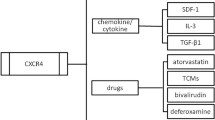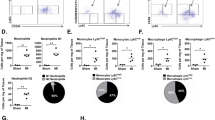Abstract
A growing body of preclinical evidence suggests that mesenchymal stem cells (MSCs) are effective for the structural and functional recovery of the infracted heart. Accordingly, clinical trials are underway to determine the benefit of MSC-based therapies. While systemic administration of MSCs is an attractive strategy, and is the route currently used for the administration of MSCs in clinical studies for myocardial infarction, the majority of infused cells do not appear to localize to infracted myocardium in animal studies. Recently, important progress has been made in identifying chemokine receptors critical for the migration and homing of MSCs. Here, we review recent literature regarding mechanisms of MSC homing and recruitment to the ischemic myocardium, and discuss potential influences of low engraftment rates of systemically administered MSCs to the infracted heart tissue on the effects of MSC-based therapies on myocardial infarction.

Similar content being viewed by others
References
Pittenger, M. F., Mackay, A. M., Beck, S. C., et al. (1999). Multilineage potential of adult human mesenchymal stem cells. Science, 284, 143–147.
Prockop, D. J. (1997). Marrow stromal cells as stem cells for nonhematopoietic tissues. Science, 276, 71–74.
Horwitz, E. M. (2006). MSC: A coming of age in regenerative medicine. Cytotherapy, 8, 194–195.
Charwat, S., Gyongyosi, M., Lang, I., et al. (2008). Role of adult bone marrow stem cells in the repair of ischemic myocardium: Current state of the art. Experimental Hematology, 36, 672–680.
Salem, H. K., & Thiemermann, C. (2010). Mesenchymal stromal cells: Current understanding and clinical status. Stem Cells, 28, 585–596.
Amado, L. C., Saliaris, A. P., Schuleri, K. H., et al. (2005). Cardiac repair with intramyocardial injection of allogeneic mesenchymal stem cells after myocardial infarction. Proceedings of the National Academy of Sciences of the United States of America, 102, 11474–11479.
Ip, J. E., Wu, Y., Huang, J., Zhang, L., Pratt, R. E., & Dzau, V. J. (2007). Mesenchymal stem cells use integrin beta1 not CXC chemokine receptor 4 for myocardial migration and engraftment. Molecular Biology of the Cell, 18, 2873–2882.
Barbash, I. M., Chouraqui, P., Baron, J., et al. (2003). Systemic delivery of bone marrow-derived mesenchymal stem cells to the infracted myocardium: Feasibility, cell migration, and body distribution. Circulation, 108, 863–868.
LaPar, D. J., Kron, I. L., & Yang, Z. (2009). Stem cell therapy for ischemic heart disease: Where are we? Current Opinion in Organ Transplantation, 14, 79–84.
Lapidot, T., Dar, A., & Kollet, O. (2005). How do stem cells find their way home? Blood, 106, 1901–1910.
Hare, J. M., Traverse, J. H., Henry, T. D., et al. (2009). A randomized, double-blind, placebo-controlled, dose-escalation study of intravenous adult human mesenchymal stem cells (prochymal) after acute myocardial infarction. Journal of the American College of Cardiology, 54, 2277–2286.
Rombouts, W. J., & Ploemacher, R. E. (2003). Primary murine MSC show highly efficient homing to the bone marrow but lose homing ability following culture. Leukemia, 17, 160–170.
Assis, A. C., Carvalho, J. L., Jacoby, B. A., et al. (2010). Time-dependent migration of systemically delivered bone marrow mesenchymal stem cells to the infracted heart. Cell Transplantation, 19, 219–230.
Kraitchman, D. L., Tatsumi, M., Gilson, W. D., et al. (2005). Dynamic imaging of allogeneic mesenchymal stem cells trafficking to myocardial infarction. Circulation, 112, 1451–1461.
Vos, O., Luiten, F., & Ploemacher, R. E. (1980). Lodging of CFU(S) under various circumstances in bone marrow, spleen and liver. Experimental Hematology, 8, 860–866.
Freyman, T., Polin, G., Osman, H., et al. (2006). A quantitative, randomized study evaluating three methods of mesenchymal stem cell delivery following myocardial infarction. European Heart Journal, 27, 1114–1122.
Honczarenko, M., Le, Y., Swierkowski, M., Ghiran, I., Glodek, A. M., & Silberstein, L. E. (2006). Human bone marrow stromal cells express a distinct set of biologically functional chemokine receptors. Stem Cells, 24, 1030–1041.
Mangi, A. A., Noiseux, N., Kong, D., et al. (2003). Mesenchymal stem cells modified with Akt prevent remodeling and restore performance of infracted hearts. Nature Medicine, 9, 1195–1201.
Schneider, C., Krause, K., Jaquet, K., et al. (2008). Intramyocardial transplantation of bone marrow-derived stem cells: Ultrasonic strain rate imaging in a model of hibernating myocardium. Journal of Cardiac Failure, 14, 861–872.
Miyahara, Y., Nagaya, N., Kataoka, M., et al. (2006). Monolayered mesenchymal stem cells repair scarred myocardium after myocardial infarction. Nature Medicine, 12, 459–465.
Perin, E. C., Silva, G. V., Assad, J. A., et al. (2008). Comparison of intracoronary and transendocardial delivery of allogeneic mesenchymal cells in a canine model of acute myocardial infarction. Journal of Molecular and Cellular Cardiology, 44, 486–495.
Heldman, A. W., & Hare, J. M. (2008). Cell therapy for myocardial infarction: Special delivery. Journal of Molecular and Cellular Cardiology, 44, 473–476.
Chavakis, E., Urbich, C., & Dimmeler, S. (2008). Homing and engraftment of progenitor cells: A prerequisite for cell therapy. Journal of Molecular and Cellular Cardiology, 45, 514–522.
Ruster, B., Gottig, S., Ludwig, R. J., et al. (2006). Mesenchymal stem cells display coordinated rolling and adhesion behavior on endothelial cells. Blood, 108, 3938–3944.
McEver, R. P. (2010). Rolling back neutrophil adhesion. Nature Immunology, 11, 282–284.
Imhof, B. A., & Aurrand-Lions, M. (2004). Adhesion mechanisms regulating the migration of monocytes. Nature Reviews Immunology, 4, 432–444.
Kamei, M., & Carman, C. V. (2010). New observations on the trafficking and diapedesis of monocytes. Current Opinion in Hematology, 17, 43–52.
Katayama, Y., Hidalgo, A., Furie, B. C., Vestweber, D., Furie, B., & Frenette, P. S. (2003). PSGL-1 participates in E-selectin-mediated progenitor homing to bone marrow: Evidence for cooperation between E-selectin ligands and {alpha}4 integrin. Blood, 102, 2060–2067.
Hynes, R. O. (2002). Integrins: Bidirectional, allosteric signaling machines. Cell, 110, 673–687.
Muller, W. A. (2009). Mechanisms of transendothelial migration of leukocytes. Circulation Research, 105, 223–230.
Sorokin, L. (2010). The impact of the extracellular matrix on inflammation. Nature Reviews Immunology, 10, 712–723.
Wu, Y., Ip, J. E., Huang, J., et al. (2006). Essential role of ICAM-1/CD18 in mediating EPC recruitment, angiogenesis, and repair to the infracted myocardium. Circulation Research, 99, 315–322.
Frangogiannis, N. G. (2004). Chemokines in the ischemic myocardium: From inflammation to fibrosis. Inflammation Research, 53, 585–595.
Herrera, M. B., Bussolati, B., Bruno, S., et al. (2007). Exogenous mesenchymal stem cells localize to the kidney by means of CD44 following acute tubular injury. Kidney International, 72, 430–441.
Viswanathan, A., Painter, R. G., Lanson, N. A., Jr., & Wang, G. (2007). Functional expression of N-formyl peptide receptors in human bone marrow-derived mesenchymal stem cells. Stem Cells, 25, 1263–1269.
Ponte, A. L., Marais, E., Gallay, N., et al. (2007). The in vitro migration capacity of human bone marrow mesenchymal stem cells: Comparison of chemokine and growth factor chemotactic activities. Stem Cells, 25, 1737–1745.
Brooke, G., Tong, H., Levesque, J. P., & Atkinson, K. (2008). Molecular trafficking mechanisms of multipotent mesenchymal stem cells derived from human bone marrow and placenta. Stem Cells and Development, 17, 929–940.
Bromley, S. K., Mempel, T. R., & Luster, A. D. (2008). Orchestrating the orchestrators: Chemokines in control of T cell traffic. Nature Immunology, 9, 970–980.
Lazennec, G., & Richmond, A. (2010). Chemokines and chemokine receptors: New insights into cancer-related inflammation. Trends in Molecular Medicine, 16, 133–144.
Schenk, S., Mal, N., Finan, A., et al. (2007). Monocyte chemotactic protein-3 is a myocardial mesenchymal stem cell homing factor. Stem Cells, 25, 245–251.
Shi, M., Li, J., Liao, L., et al. (2007). Regulation of CXCR4 expression in human mesenchymal stem cells by cytokine treatment: Role in homing efficiency in NOD/SCID mice. Haematologica, 92, 897–904.
Chamberlain, G., Wright, K., Rot, A., Ashton, B., & Middleton, J. (2008). Murine mesenchymal stem cells exhibit a restricted repertoire of functional chemokine receptors: Comparison with human. PloS One, 3, e2934.
McQuibban, G. A., Gong, J. H., Tam, E. M., McCulloch, C. A., Clark-Lewis, I., & Overall, C. M. (2000). Inflammation dampened by gelatinase A cleavage of monocyte chemoattractant protein-3. Science, 289, 1202–1206.
Huang, J., Zhang, Z., Guo, J., et al. (2010). Genetic modification of mesenchymal stem cells overexpressing CCR1 increases cell viability, migration, engraftment, and capillary density in the injured myocardium. Circulation Research, 106, 1753–1762.
Belema-Bedada, F., Uchida, S., Martire, A., Kostin, S., & Braun, T. (2008). Efficient homing of multipotent adult mesenchymal stem cells depends on FROUNT-mediated clustering of CCR2. Cell Stem Cell, 2, 566–575.
Belema Bedada, F., Technau, A., Ebelt, H., Schulze, M., & Braun, T. (2005). Activation of myogenic differentiation pathways in adult bone marrow-derived stem cells. Molecular and Cellular Biology, 25, 9509–9519.
Abbott, J. D., Huang, Y., Liu, D., Hickey, R., Krause, D. S., & Giordano, F. J. (2004). Stromal cell-derived factor-1 alpha plays a critical role in stem cell recruitment to the heart after myocardial infarction but is not sufficient to induce homing in the absence of injury. Circulation, 110, 3300–3305.
Askari, A. T., Unzek, S., Popovic, Z. B., et al. (2003). Effect of stromal-cell-derived factor 1 on stem-cell homing and tissue regeneration in ischaemic cardiomyopathy. The Lancet, 362, 697–703.
Wynn, R. F., Hart, C. A., Corradi-Perini, C., et al. (2004). A small proportion of mesenchymal stem cells strongly expresses functionally active CXCR4 receptor capable of promoting migration to bone marrow. Blood, 104, 2643–2645.
Sordi, V., Malosio, M. L., Marchesi, F., et al. (2005). Bone marrow mesenchymal stem cells express a restricted set of functionally active chemokine receptors capable of promoting migration to pancreatic islets. Blood, 106, 419–427.
Cheng, Z., Ou, L., Zhou, X., et al. (2008). Targeted migration of mesenchymal stem cells modified with CXCR4 gene to infracted myocardium improves cardiac performance. Molecular Therapy, 16, 571–579.
Wojakowski, W., Tendera, M., Michalowska, A., et al. (2004). Mobilization of CD34/CXCR4+, CD34/CD117+, c-met + stem cells, and mononuclear cells expressing early cardiac, muscle, and endothelial markers into peripheral blood in patients with acute myocardial infarction. Circulation, 110, 3213–3220.
Wang, Y., Johnsen, H. E., Mortensen, S., et al. (2006). Changes in circulating mesenchymal stem cells, stem cell homing factor, and vascular growth factors in patients with acute ST elevation myocardial infarction treated with primary percutaneous coronary intervention. Heart, 92, 768–774.
Binger, T., Stich, S., Andreas, K., et al. (2009). Migration potential and gene expression profile of human mesenchymal stem cells induced by CCL25. Experimental Cell Research, 315, 1468–1479.
Zhu, J., Zhou, Z., Liu, Y., & Zheng, J. (2009). Fractalkine and CX3CR1 are involved in the migration of intravenously grafted human bone marrow stromal cells toward ischemic brain lesion in rats. Brain Research, 1287, 173–183.
Hung, S. C., Pochampally, R. R., Hsu, S. C., et al. (2007). Short-term exposure of multipotent stromal cells to low oxygen increases their expression of CX3CR1 and CXCR4 and their engraftment in vivo. PloS One, 2, e416.
Ringe, J., Strassburg, S., Neumann, K., et al. (2007). Towards in situ tissue repair: Human mesenchymal stem cells express chemokine receptors CXCR1, CXCR2 and CCR2, and migrate upon stimulation with CXCL8 but not CCL2. Journal of Cellular Biochemistry, 101, 135–146.
Von, L. I., Notohamiprodjo, M., Wechselberger, A., et al. (2005). Human adult CD34- progenitor cells functionally express the chemokine receptors CCR1, CCR4, CCR7, CXCR5, and CCR10 but not CXCR4. Stem Cells and Development, 14, 329–336.
Acknowledgements
We thank Xusheng Wang and Ying Zhou for assistances in drawing graphs and collecting data. This work was supported by grants from Natural Science Foundation of China (No. 30871273, 30971496, U1032003) to Y Wu.
Disclosures
The authors indicate no potential conflicts of interest.
Author information
Authors and Affiliations
Corresponding author
Rights and permissions
About this article
Cite this article
Wu, Y., Zhao, R.C.H. The Role of Chemokines in Mesenchymal Stem Cell Homing to Myocardium. Stem Cell Rev and Rep 8, 243–250 (2012). https://doi.org/10.1007/s12015-011-9293-z
Published:
Issue Date:
DOI: https://doi.org/10.1007/s12015-011-9293-z




